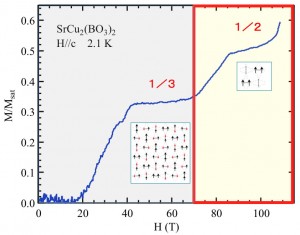Observation of novel quantum phases in 2-dimensional magnet at ultrahigh magnetic fields Exotic quantum phenomena in orthogonal spin dimer system

Quantum phenomena sometimes show up in low dimensional materials. Experimental study of such phenomena and comparison of the results with theoretical models are important from two viewpoints; one is the verification of theory based on the quantum mechanics, and the other is the accumulation of knowledge for development of novel quantum devices.

© Yasuhiro H. Matsuda, Magnetization curve in a two dimensional orthogonal spin dimer system SrCu2(BO3)2 up to 118 Tesla. The region marked by the red line is the result observed in the present work. It is found that the length of the 1/2 plateau is shorter than that of the 1/3 plateau and there is a finite slope for the 1/2 plateau. This fact indicates that the 1/2 plateau is unstable compared to the 1/3 plateau.
Two-dimensional (2D) magnets have been intensively studied for both these reasons. SrCu2(BO3)2 is one of the best studied 2D magnets for its fascinating magnetic properties. The nearest neighbor S=1/2 Cu spins couples antiferromagnetically and form singlet dimers through the exchange interaction.
The magnetization process of SrCu2(BO3)2 shows an exotic multi-plateau structure, indicating the crystallization of the excited triplet dimers with several factional fillings in the sea of singlet dimers. This phenomenon is determined by the strong quantum effect and has attracted much attention for a long time. However, experimental study has been performed only for 1/3 of the whole magnetization process because a very high magnetic field is required for the experiment.
Associate professor Yasuhiro H. Matsuda and others in the Institute for Solid State Physics (ISSP), University of Tokyo, have succeeded in observing the magnetization curve of SrCu2(BO3)2 in ultrahigh magnetic fields of up to 118 Tesla in collaboration with Prof. Hiroshi Kageyama in the Faculty of Engineering, Kyoto University. The long-predicted 1/2 plateau has been clearly observed at the field range from 84 to 108 Tesla for the first time. The unique “single-turn coil method” (STC) magnetic field generator was used for the experiment; there are only four STC systems in the world and two of these are installed in ISSP.
Furthermore, in collaboration with professor Frederic Mila in Institute of Theoretical Physics, EPFL, Lausanne, Switzerland, and other theoreticians it has been confirmed that the theoretical model based on the quantum mechanics quantitatively explains the observed 1/2 plateau. In addition to the 1/2 plateau, other novel phases in the vicinity of the 1/2 plateau are also predicated by the theory.
Press release [pdf] (Japanese)
Paper
Y. H. Matsuda, N. Abe, S. Takeyama, H. Kageyama, P. Corboz, A. Honecker, S. R. Manmana, G. R. Foltin, K. P. Schmidt, and F. Mila,
“Magnetization of SrCu2(BO3)2 in Ultrahigh Magnetic Fields up to 118 T”,
Physical Review Letters Online Edition: 2013/9/26 (Japan time), doi: 10.1103/PhysRevLett.111.137204.
Article link
Links
Institute for Solid State Physics
International MegaGauss Science Laboratory, Institute for Solid State Physics
Y. Matsuda Group, International MegaGauss Science Laboratory, Institute for Solid State Physics






